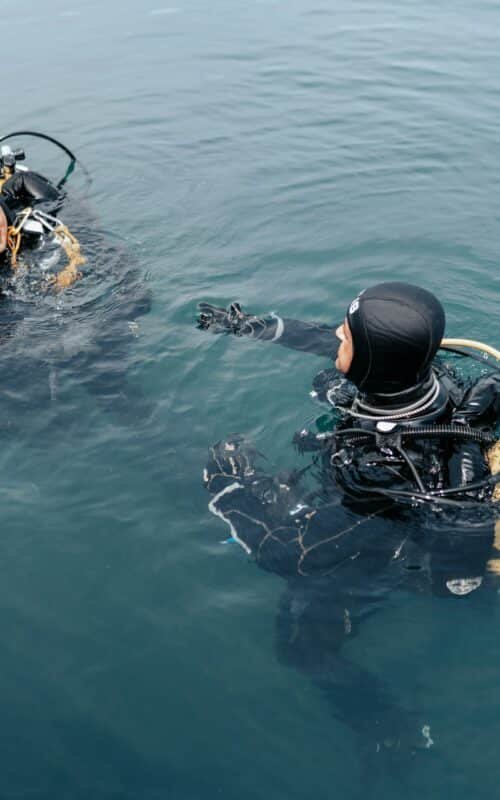Every time we plunge into the deep blue, our main priority at Master Divers is ensuring the safety of all our divers. Scuba diving, while exhilarating and eye-opening, carries inherent risks that must be managed with proper knowledge and preparation. Understanding these risks and how to mitigate them can significantly enhance your diving experience, making it not only enjoyable but also secure. Here, we aim to equip you with critical information and techniques to navigate the most common diving hazards.
Before any dive, we walk through a series of structured checks and balances designed to safeguard our divers. From equipment inspection to understanding each dive site’s specific challenges, our rigorous safety protocols are in place to prevent any untoward incidents. It’s not just about getting into the water; it’s about doing so with confidence and assurance. By adhering to well-established safety procedures and adopting responsible diving practices, we can enjoy the marvels of the underwater world while minimizing risks. This foundational approach to diving safety is what enables divers at all levels to build their skills on a platform of trust and safety.
Understanding Common Diving Hazards: What Every Diver Should Know
As you begin your scuba diving journey, it’s crucial to be aware of the common hazards that can occur underwater. Knowledge is the first line of defense against potential risks, enabling us to immensely engage with the beauty of the ocean safely. A primary hazard that divers face is changes in water pressure, which can affect the body in various ways, notably causing decompression sickness if ascent is not managed correctly. Equally important to understand are the risks from the marine environment itself, including dangerous marine life and unpredictable ocean currents.
Another less considered but significant risk is equipment failure. While modern diving equipment is highly reliable, malfunctions can still occur, and knowing how to respond is essential. This covers everything from a leaking mask to a malfunctioning regulator. We emphasize regularly checking your gear, knowing its workings intimately, and always having a contingency plan, such as carrying a spare mask or knowing the hand signals to communicate equipment issues to your dive buddy.
Essential Pre-Dive Safety Checks: Our Checklist for a Safe Dive
Before diving in, performing a series of safety checks is imperative. We advocate for a culture of safety where every diver, regardless of experience level, adheres to this routine. Our pre-dive safety checklist is designed to mitigate risks and ensure that you’re completely prepared for the dive. First, verify that all your equipment is functional and properly set up. This includes checking your air supply is full and that all valves are fully operational.
Next, inspect your buoyancy control device (BCD) to ensure it inflates and deflates properly. Check your fins and mask for any signs of wear or damage, and make sure your weights are secure but can be easily released in emergencies. We also recommend a thorough briefing with every diver involved in the dive to review dive plans, communication signals, and emergency procedures. This collaborative approach not only increases safety but also enhances the overall diving experience, as each person becomes a supportive link in the dive team’s safety chain.
Effective Communication Techniques Underwater
When we’re diving, the ability to communicate effectively underwater is vital. Due to the inability to speak, we rely on hand signals and written messages to express ourselves. Understanding and using these signals correctly is fundamental to our safety and coordination during dives. Every diver, from beginner to advanced, must be fluent in these hand gestures, which cover everything from basic needs like “up”, “down”, “okay”, or “trouble”, to more specific signals for marine life sightings.
Additionally, carrying a dive slate or waterproof notebook allows for more complex communication. This can be essential in situations where detailed instructions or information needs to be shared. We also train in the use of dive alerts and underwater horns, which can capture the attention of other divers over longer distances. These tools complement hand signals to enhance safety and interaction between dive team members, ensuring everyone can stay connected and aware, regardless of visibility conditions.
Post-Dive Procedures: Ensuring Safety After Surfacing
After enjoying the underwater world, ensuring everyone’s safety upon returning to the surface is crucial. Our post-dive procedures start with a controlled, gradual ascent, followed by a safety stop, typically at five meters for about three to five minutes to prevent decompression sickness. Once surfaced, we signal the boat or shore team with an OK sign, and then await pickup, keeping our BCDs inflated for visibility and buoyancy.
Once aboard, it’s essential to begin managing our equipment immediately, ensuring it is secure and starting the rinsing process to remove saltwater, which can damage the gear over time. We also encourage a debrief session among the dive group to discuss the dive, noting any issues and celebrating sightings. This not only enhances our diving skills but also reinforces the bond within the diving community by sharing our experiences and learnings.
Conclusion
Exploring the blue abyss with scuba diving unveils a world filled with vibrant marine life, enchanting coral reefs, and countless adventure opportunities. Understanding the hazards, preparing properly before dives, communicating effectively underwater, and following rigorous post-dive procedures are all cornerstone practices that enhance our safety and enjoyment. At Master Divers, we are committed to ensuring that every diver gains the skills, knowledge, and confidence needed for safe and fulfilling diving adventures.
Whether you are taking your first breath underwater or looking to advance your diving skills, join us in embracing this extraordinary sport. Discover unparalleled underwater experiences with the best diving school in Koh Tao, Master Divers, where safety and passion come together to offer you the best in diving adventures. Join our community to explore, learn, and conserve the underwater world we all cherish so much!

